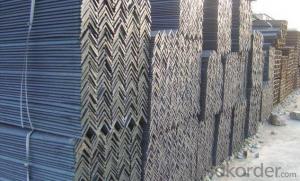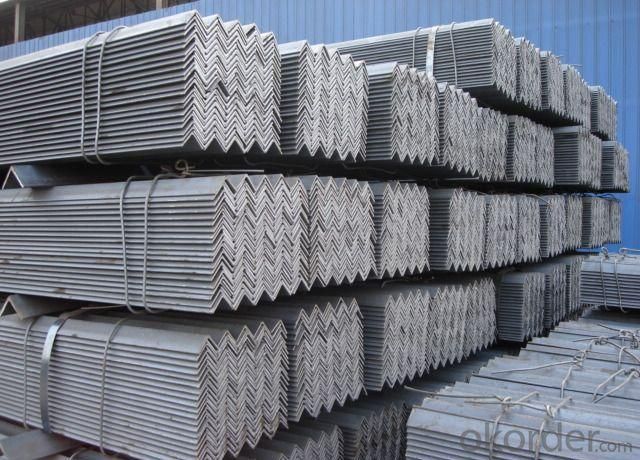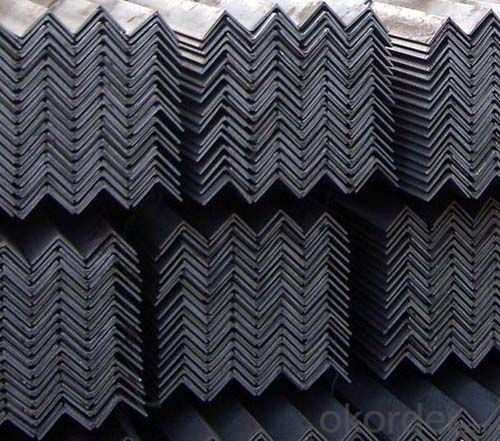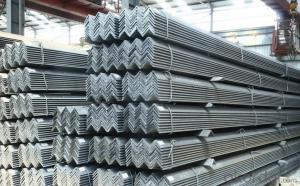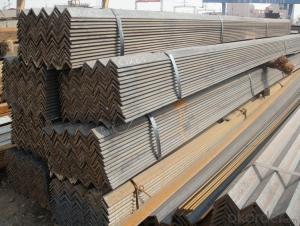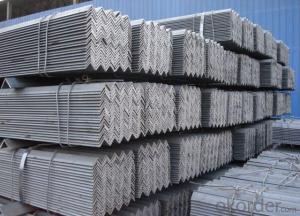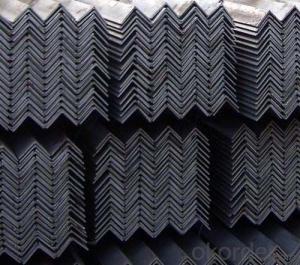Steel Equal Angle with Good Quality 100*100*6.0-12.0mm
- Loading Port:
- Tianjin
- Payment Terms:
- TT OR LC
- Min Order Qty:
- 50 m.t
- Supply Capability:
- 15000 m.t/month
OKorder Service Pledge
OKorder Financial Service
You Might Also Like
Specification
Product Description:
Specifications of Steel Equal Angle with Good Quality 100*100*6.0-12.0mm:
1. Invoicing on theoretical weight or actual weight as customer request
2. Length: 6m, 9m, 12m as following table
3. Sizes
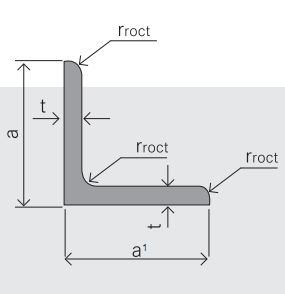
| Size(mm) | Mass(Kg/m) | Size(mm) | Mass(Kg/m) |
| 100*100*6.0 | 9.366 | 100*100*10.0 | 15.12 |
| 100*100*7.0 | 10.83 | 100*100*12.0 | 17.898 |
| 100*100*8.0 | 12.276 |
Payment terms:
1).100% irrevocable L/C at sight.
2).30% T/T prepaid and the balance against the copy of B/L.
3).30% T/T prepaid and the balance against L/C
Material details:
Grade | Element (%) | ||||
C | Mn | S | P | Si | |
Q235 | 0.12—0.20 | 0.3—0.7 | ≤0.045 | ≤0.045 | ≤0.3 |
Usage & Applications of Steel Equal Angle with Good Quality 100*100*6.0-12.0mm:
According to the needs of different structures, Angle can compose to different force support component, and also can be the connections between components. It is widely used in various building structures and engineering structures such as roof beams, bridges, transmission towers, hoisting machinery and transport machinery, ships, industrial furnaces, reaction tower, container frame and warehouse etc.
Packaging & Delivery of Steel Equal Angle with Good Quality 100*100*6.0-12.0mm:
1. Packing: it is nude packed in bundles by steel wire rod
2. Bundle weight: not more than 3.5MT for bulk vessel; less than 3 MT for container load
3. Marks:
Color marking: There will be color marking on both end of the bundle for the cargo delivered by bulk vessel. That makes it easily to distinguish at the destination port.
Tag mark: there will be tag mark tied up on the bundles. The information usually including supplier logo and name, product name, made in China, shipping marks and other information request by the customer.
If loading by container the marking is not needed, but we will prepare it as customer request.
Production flow of Steel Equal Angle with Good Quality 100*100*6.0-12.0mm:
Material prepare (billet) —heat up—rough rolling—precision rolling—cooling—packing—storage and transportation
FAQ:
Q1: Why buy Materials & Equipment from OKorder.com?
A1: All products offered byOKorder.com are carefully selected from China's most reliable manufacturing enterprises. Through its ISO certifications, OKorder.com adheres to the highest standards and a commitment to supply chain safety and customer satisfaction.
Q2: How do we guarantee the quality of our products?
A2: We have established an advanced quality management system which conducts strict quality tests at every step, from raw materials to the final product. At the same time, we provide extensive follow-up service assurances as required.
Q3: How soon can we receive the product after purchase?
A3: Within three days of placing an order, we will begin production. The specific shipping date is dependent upon international and government factors, but is typically 1 to 2 months.
Q4: How many tons can be loaded into one 20ft container?
A4: Around 23—25tons
Images of Steel Equal Angle with Good Quality 100*100*6.0-12.0mm:
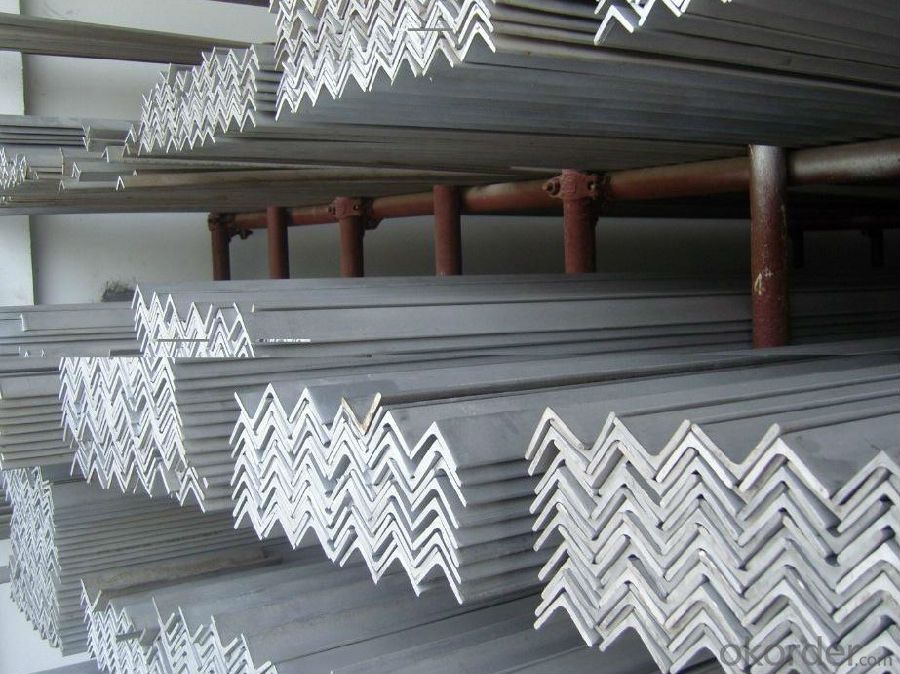

- Q: How do steel angles contribute to the overall aesthetic of a structure?
- Steel angles can contribute to the overall aesthetic of a structure by adding visual interest and architectural appeal. They can be used to create sharp, clean lines, enhance the structural integrity, and provide a modern, industrial look. Additionally, steel angles can be customized to various sizes and finishes, allowing for creative design possibilities and the ability to match the desired aesthetic of the structure.
- Q: Are steel angles suitable for earthquake-resistant structures?
- Steel angles are commonly used in earthquake-resistant structures due to their high strength and ductility properties. The angular shape of these structural members allows them to effectively resist lateral forces caused by seismic events. The ability of steel angles to absorb and dissipate energy during an earthquake makes them suitable for withstanding the dynamic loads generated by ground motions. Additionally, steel angles can be easily connected and joined together, providing a high level of structural integrity and ensuring the overall stability of the building. These factors make steel angles a favorable choice for earthquake-resistant structures, as they offer a reliable and durable solution for mitigating the impact of seismic events.
- Q: Can steel angles be used in framing?
- Yes, steel angles can be used in framing. Steel angles are commonly used in construction for framing purposes due to their strength, durability, and versatility. They are often used to provide structural support and stability in various building applications, including framing walls, floors, roofs, and other structural elements.
- Q: What is the difference between equal and unequal steel angles?
- Structural steel components commonly used in construction and industrial applications include equal and unequal steel angles. The dimensions and properties of these angles are what set them apart. Equal steel angles, also known as L-shaped angles, have sides and angles that are the same. They are frequently employed to provide support and stability in various structures like buildings, bridges, and machinery. The symmetrical load distribution and balanced strength in all directions make them perfect for applications requiring equal support on both sides. In contrast, unequal steel angles have sides and angles that differ. These angles are used when there is a need for uneven load distribution or a specific angle for a particular job. The longer side of the angle typically carries the load, while the shorter side can provide additional support or serve as a connection point. Unequal angles are commonly used in constructing frames, brackets, and supports where uneven load distribution is expected. Both equal and unequal steel angles are made from carbon steel, which offers good strength and durability. They can be either hot-rolled or cold-formed, depending on the manufacturing process. Hot-rolled angles are produced at high temperatures, resulting in a rough surface finish but improved mechanical properties. On the other hand, cold-formed angles are shaped and bent at room temperature, resulting in a smoother surface finish but slightly lower mechanical properties. In conclusion, the main distinction between equal and unequal steel angles lies in their dimensions and load distribution abilities. Equal angles have identical sides and are used for symmetrical load distribution, while unequal angles have different side lengths and are used for uneven load distribution or specific angle requirements. Both types of angles are made from carbon steel and find common usage in construction and industrial applications.
- Q: How do you calculate the effective length of a steel angle?
- To calculate the effective length of a steel angle, you need to consider its end conditions and support conditions. It is determined by analyzing the buckling behavior and stability of the angle under different loading conditions. This involves considering factors such as fixed or pinned ends, bracing conditions, and the angle's geometric properties. By applying relevant formulas or structural analysis methods, you can determine the effective length and use it to assess the angle's structural stability and design requirements.
- Q: What are the limitations of using steel angles in corrosive or saltwater environments?
- The main limitations of using steel angles in corrosive or saltwater environments are their susceptibility to corrosion and potential for accelerated deterioration. Steel angles are prone to rusting and corrosion when exposed to moisture and saltwater, which can weaken the structural integrity of the material over time. To mitigate these limitations, protective coatings or alternative materials such as stainless steel or galvanized steel can be used.
- Q: How do steel angles perform under static or stationary loading conditions?
- Steel angles are commonly used in construction and engineering applications due to their strength and versatility. Under static or stationary loading conditions, steel angles exhibit excellent performance and stability. Static loading refers to a situation where a load is applied to the angle and remains constant without any motion. Steel angles are specifically designed to withstand such loading conditions. Due to their structural properties, steel angles have a high resistance to bending and twisting forces. This allows them to effectively support heavy loads without experiencing significant deformation or failure. Steel angles distribute the applied load evenly along their length, which helps to minimize stress concentrations. This property ensures that the angle can efficiently transfer the load to the supporting structure, providing stability and structural integrity. Additionally, steel angles can withstand compressive forces, which try to shorten or compress the material. The shape and cross-section of steel angles, specifically their L-shaped profile, contribute to their ability to resist compressive loading. This feature makes steel angles suitable for applications where static loads exert compressive forces, such as columns, beams, and bracing elements. Moreover, steel angles have a high resistance to shear forces, which occur when two or more parts of a structure slide or move in opposite directions. The design of steel angles, with their perpendicular legs, enhances their shear strength, allowing them to effectively resist shear loading under stationary conditions. In summary, steel angles perform exceptionally well under static or stationary loading conditions. Their structural properties, such as resistance to bending, twisting, compression, and shear forces, make them suitable for a wide range of applications in construction and engineering.
- Q: What size does angle iron 125*10 mean?
- The sides are 125*125*10MM thick and the theoretical weight is 19.133 per meter
- Q: How are steel angles used in framing?
- Steel angles are commonly used in framing to provide structural support and stability. They are typically used to connect and reinforce various components of a frame, such as beams, columns, and trusses. Steel angles are often bolted or welded at specific locations to create a rigid framework that can withstand loads and distribute them evenly. This helps ensure the overall strength and integrity of the framed structure.
- Q: Can steel angles be used for manufacturing window frames?
- Yes, steel angles can be used for manufacturing window frames. Steel angles are commonly used in construction and fabrication due to their strength and durability. They provide structural support and can be easily welded or bolted together to create window frames that are sturdy and long-lasting.
Send your message to us
Steel Equal Angle with Good Quality 100*100*6.0-12.0mm
- Loading Port:
- Tianjin
- Payment Terms:
- TT OR LC
- Min Order Qty:
- 50 m.t
- Supply Capability:
- 15000 m.t/month
OKorder Service Pledge
OKorder Financial Service
Similar products
Hot products
Hot Searches
Related keywords
